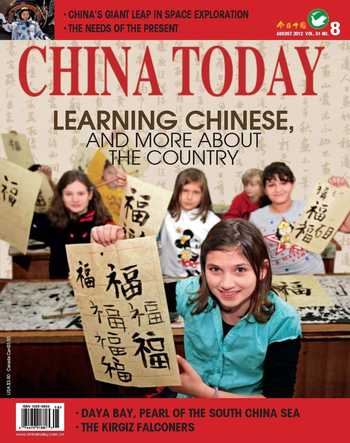Calligraphy, Then and Now
one of the most respected traditional arts in China. And thats saying a lot in a country whose cultural legacy stretches back 5,000 years.
In the narrow sense of the word, calligraphy refers to artful, brush-drawn handwriting. But in the broad sense, it is much more than that.
Chinese calligraphy falls into five major styles, namely zhuanshu(seal script), lishu (clerical script), caoshu (cursive script), kaishu(regular script) and xingshu (running script). Each style is further classified into several schools; for example, running scripts main subdivisions are regular running script and cursive running script.
In a 2012 auction focusing on ancient Chinese calligraphic works held by China Guardian Auctions Co., Ltd., A Poem About Horse Painting, a running script piece by Ming Dynasty scholar Li Dongyang (1447-1516), fetched the fabulous sum of RMB 17.25 million.
A civil minister by profession, Li was also renowned for his mastery of calligraphy. He was competent in the seal script and the clerical script, and was especially noted for his running cursive script prowess. His calligraphic works usually blended a triad of forceful, vigorous and graceful strokes.
A Poem About Horse Painting is typical of Lis style. The work was made on a superb piece of silk fabric woven especially with calligraphy in mind. He used first-rate ink, which was crucial in ensuring the longevity of the work. One of the pieces first owners was Xiang Zijing (1525-1590), a famous collector who was purported to have the largest collection of artwork in Chinese history. It was later inscribed by Liu Jiuan, a renowned appraiser of calligraphic works at Beijings Palace Museum. With this history, its not surprising that the work was sold for a record-high price.
Since Chinas earliest Chinese characters – jiaguwen – were etched onto ox scapulas and tortoise shells, Chinese calligraphy had evolved greatly. From earlier scripts, such as the zhuanshu (seal script) and the lishu (clerical script), other styles began to take precedence, such as caoshu (cursive script), kaishu (regular script) and xingshu (running script).
Around 220 B.C., after Emperor Qin Shihuang conquered surrounding kingdoms and united China, he set about unifying different styles of characters used by various kingdoms into a set of standard characters called xiaozhuan.
The following several hundred years saw a proliferation of sub-styles, such as the aforementioned lishu, caoshu, kaishu and xingshu. But it was really during the period of the Wei, Jin, and Southern and Northern Dynasties from 220 to 589 that Chinese calligraphy flourished. Formal calligraphic theories also began to appear, and calligraphy became a much-respected art form.
The names of prominent calligraphers of the Wei and Jin dynasties are still recalled with ease today. They went on to exert an immense influence on subsequent generations of artists, and their works have been cherished as eternal classics of Chinese calligraphy.
Among these masters was Wang Xizhi (303-361), regarded as Chinas “Saint of Calligraphy” and the most masterful calligrapher the country has ever seen. One of his works,Preface to the Orchid Pavilion Collection (Lantingji Xu), is regarded as the worlds premier example of the running script style.
In succeeding dynasties, many renowned calligraphers produced masterpieces, such as Ouyang Xun (557-641), Yan Zhenqing (709-785) and Liu Gongquan (778 -865) of the Tang Dynasty, and Huang Tingjian (1045-1105) and Mi Fu (1051-1107) of the Northern Song Dynasty (960-1127), and Zhao Mengfu (1254-1322) of the Yuan Dynasty. In a 2010 Spring Auction run by the Beijing Poly International Auction Company, Inscription on the Chief Cornerstone (Dizhu Ming), one of Huang Tingjians works, was auctioned for RMB 436.8 million, triggering an explosion of domestic and international media coverage. Also in 2010, Wang Xizhis Pingan Tie fetched the sky-high price of RMB 308 million at the Autumn Auction of China Guardian.
Since ancient times, Chinese people have held the opinion that practicing calligraphy cultivates ones character and nourishes the soul. This idea is deeply ingrained in the collective Chinese conscience. There is an old adage in Chinese:“Calligraphy is a true reflection of spirit” – i.e., calligraphy reveals a persons personality and gives expression to their joys and sorrows.
Many modern calligraphers believe that calligraphy, which requires one to be calm, collected and reflective, should appeal to those who lead modern, rapid-pace lives.
According to statistics, membership of the China Calligraphers Association, while still small, has expanded to nearly 10,000 people from only 100 since its founding in 1981. When counted with members of local calligraphers associations and amateur calligraphers, the number of people practicing calligraphy in China could be one million.
Apart from brush calligraphy, China also boasts a kind of hard-tipped pen calligraphy. Although some argue that the first Chinese characters, jiaguwen, marked the inception of Chinas hard-tipped pen calligraphic tradition, it was not until the early 20th century when the fountain pen was introduced to China that hard-tipped pen calligraphy became popular in the country. One wonders what the next innovation in Chinas continuing calligraphic legacy will be.

